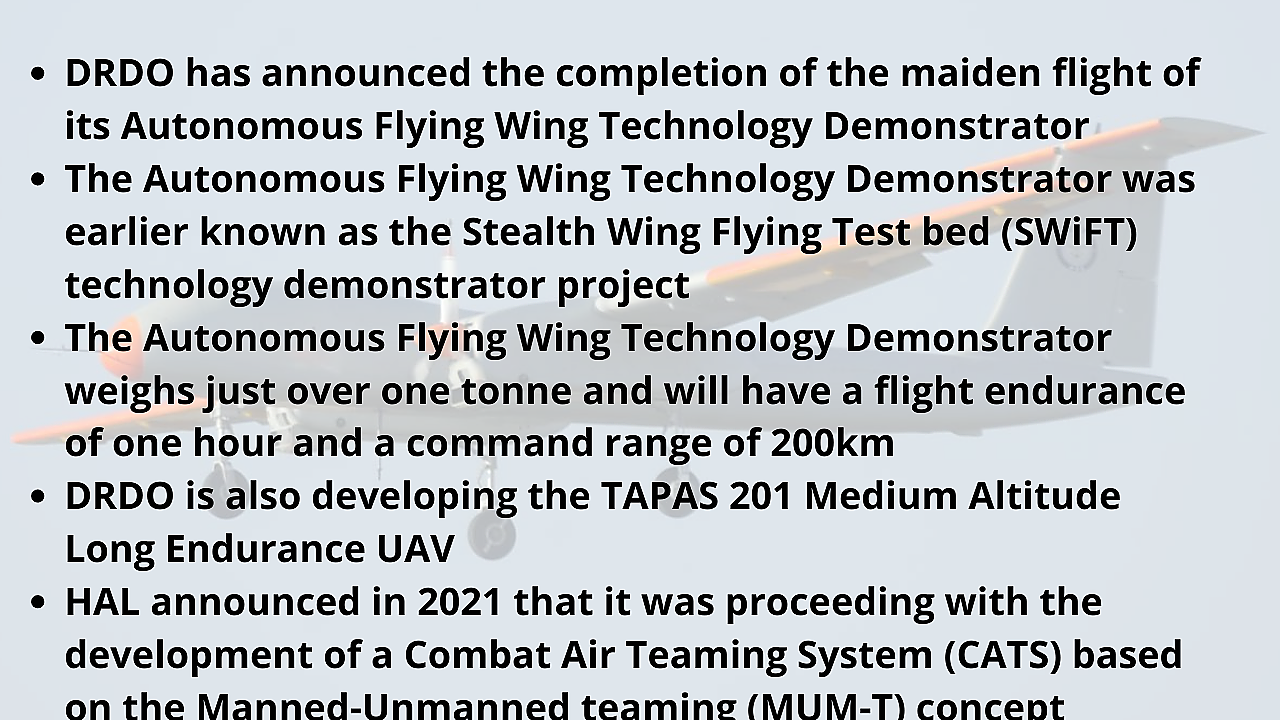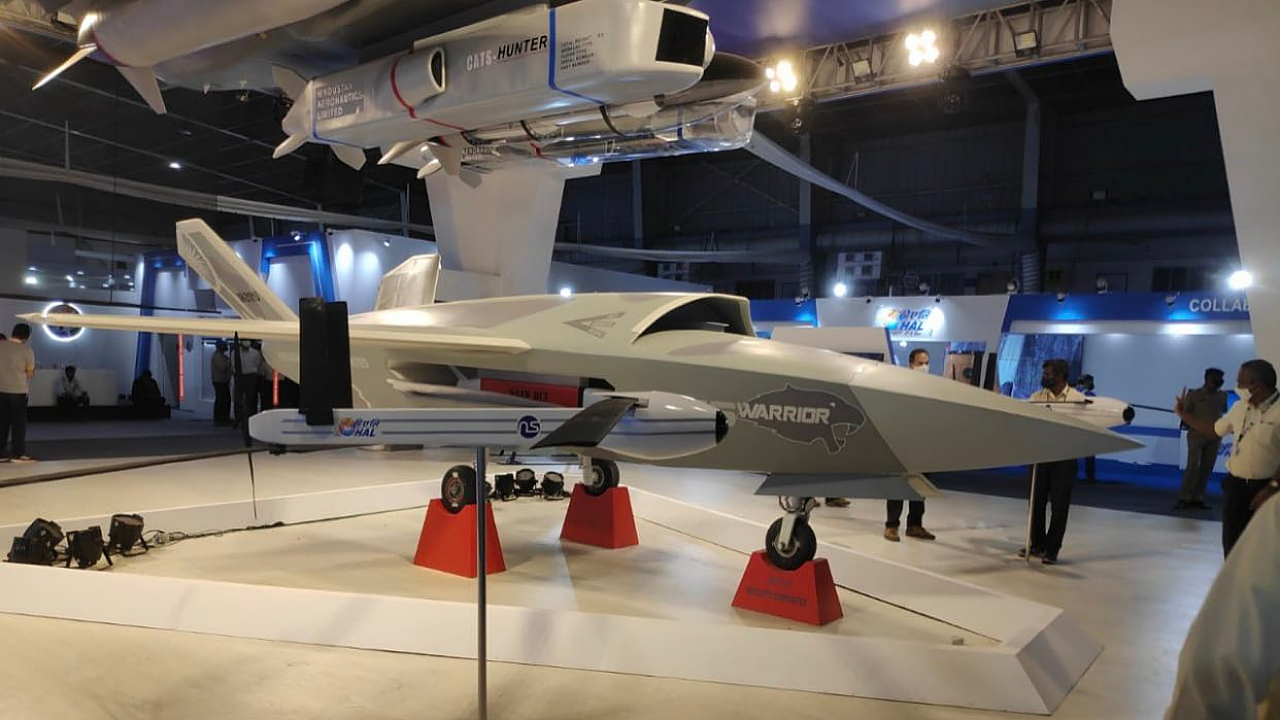
The Defence Research and Development Organisation (DRDO) has successfully completed the maiden flight of its Autonomous Flying Wing Technology Demonstrator. The futuristic-looking Unmanned Aerial Vehicle (UAV) is a scaled-down version of a potential future configuration of a much larger size.
The first flight marked a major milestone for DRDO in proving critical technologies for the development of future unmanned aircraft. In a tweet, Defence Minister Rajnath Singh said the maiden flight was a major achievement towards the development of autonomous aircraft, which would pave the way for ‘Aatmanirbhar Bharat’ in terms of critical military systems.
Flying Wing
The futuristic-looking aircraft is being designed & developed by the Aeronautical Development Establishment (ADE), located in Bengaluru. The maiden flight of the technology demonstrator UAV took place from the DRDO’s Aeronautical Test Range (ATR) in Chitradurga, Karnataka. The Autonomous Flying Wing Technology Demonstrator was earlier known as the Stealth Wing Flying Testbed (SWiFT) technology demonstrator project.
“The test aircraft was operated in fully autonomous mode and exhibited a perfect flight, including take-off, way point navigation and a smooth touchdown,” a DRDO official told Mobility Outlook. The Aeronautical Test Range, Chitradurga, is a newly developed flight test range for the testing of UAVs and manned aircraft and is 250km from Bengaluru.
The stealthy UAV is powered by a small turbofan engine imported from a foreign nation, but apart from that, the entire airframe, undercarriage, flight control and avionics systems used were developed indigenously. This advanced technology project UAV also features the use of stealth materials and stealth shaping to reduce its radar signature and also makes use of conformal antennae. It has a length of 4m and a wingspan of 5m with an All-Up Weight (AUW) of 1.05 tonne. According to information released by DRDO earlier, the stealth UAV technology demonstrator can attain a maximum altitude of 6,0000m Above Mean Sea Level. It will have a flight endurance of one hour and a command range of 200km.
ADE has developed various unmanned platforms at DRDO, such as Lakshya (1&2), Nishant, Micro & Mini UAVs, RUSTOM-1, Sudarshan, Nirbhay, TAPAS, SWiFT etc. It is also thought that the new UAV demonstrator uses a data link developed by the Defence Electronics Application Laboratory (DEAL) of DRDO for the RUSTOM – II programme. The autonomous flying wing demonstrator aims to showcase indigenous competence in developing homegrown technologies related to the controllability of a flying wing configuration, achieving high-subsonic speeds with such an unmanned design and demonstrating autonomous take-off and landing technology.
The Retractable Landing Gear (RLG) for the Autonomous Flying Wing Technology Demonstrator was designed and developed by the Combat Vehicles Research and Development Establishment (CVRDE), located at Avadi near Chennai. The Ministry of Defence (MoD) announced the handing over of the first RLG system for SWiFT UAVs by CVRDE to ADE in January. Significant challenges were involved in developing the landing gear system for the stealthy UAV as there were constraints related to the internal bay volume for the landing gear to retract. There were also weight considerations.

Despite the recent success, transitioning from a technology demonstrator to a full-size combat platform with a larger, more powerful engine, weapons and sensor payload, datalinks, etc., will be time-consuming. Reviving the moribund indigenous Kaveri turbofan engine in a non-afterburning avatar could also prove a greater challenge than originally envisaged.
TAPAS 201
ADE is also developing the TAPAS 201, Medium Altitude Long Endurance (MALE) UAV, earlier known as RUSTOM – II. The TAPAS 201 prototype made its maiden flight in November 2016. While ADE is the production agency for TAPAS-201, Hindustan Aeronautics Limited (HAL) and Bharat Electronics Limited (BEL) have been designated production partners for the UAV programme. While the TAPAS 201 prototype weighed two-tonne, production variants are likely to be heavier.
In January, the MoD announced that CVRDE had delivered the first set of an indigenously designed and developed three-tonne RLG system for the Tapas UAV. The tricycle nose wheel type multidisciplinary, hydro-electro-mechanical system is now being manufactured by an industry partner at Coimbatore.
Conceived as a multi-mission UAV, the TAPAS 201 will be able to undertake Intelligence, Surveillance and Reconnaissance (ISR) missions for all three armed forces and is slated to have an endurance of 24 hours. It will be able to carry a wide range of payloads such as long and medium-range Electro-Optic sensors, Synthetic Aperture Radar, Electronic Intelligence, Communication Intelligence and Situational Awareness Payloads.

Combat Air Teaming System
HAL is undertaking the country's most ambitious unmanned system programme with a private industry partner. Unveiled at Aero India 2021, HAL’s Combat Air Teaming System (CATS) aims to pair an LCA ‘Tejas’ Light Combat Aircraft (LCA) with various unmanned systems. The programme has been underway since late 2018 and is based on the Manned-Unmanned teaming (MUM-T) concept.
The Tejas aircraft will function as a mothership, controlling and operating alongside a low observable unmanned wingman known as ‘CATS Warrior,’ swarming UAVs called CATS Air Launched Flexible Assets and a multi-purpose explosive carrier system known as CATS Hunter. CATS ALFA is a swarming drone system carrying individual armed drones within its weapons bay. The CATS Warrior low-observable wingman is being designed as a deep penetration strike asset with a radius of action of 350 km. It will have an internal weapons bay, and development is expected to be completed by 2025-26.